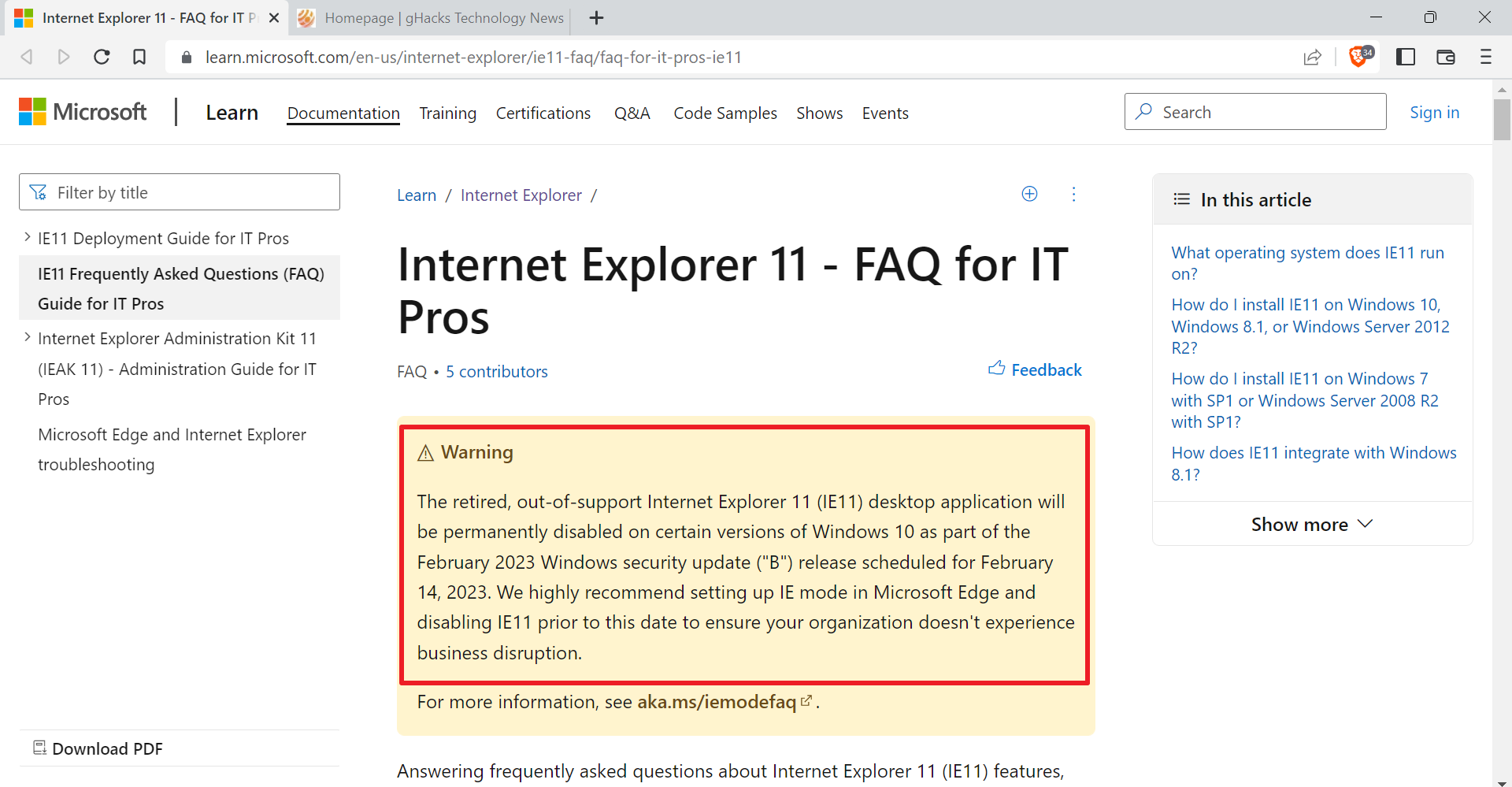Microsoft explains how it is retiring Internet Explorer

On June 15, 2022, Microsoft is retiring its Internet Explorer browser. The move affects most Windows 10 devices, but there are devices on which Internet Explorer remains available. Even on Windows 10, Internet Explorer will be retired in two phases, over the course of the coming months.

As far as the scope of the retirement is concerned, Microsoft is retiring Internet Explorer 11 only on certain Windows 10 editions. In particular, IE 11 won't be supported on most supported Windows 10 client editions and on Windows 10 IoT.
Several operating system editions and versions are not affected by the decision:
- Windows 7 and 8.1.
- Windows Server and Windows Server LTSC.
- Windows 10 client LTSC
- Windows 10 China Government Edition.
- Windows 10 IoT LTSC.
The Windows 7 (ESU) and Windows 8.1 operating systems will run out of support in 2023. Internet Explorer and other Microsoft applications will run out of support at the same time on these devices.
Internet Explorer will be redirected to Microsoft Edge on supported and unsupported versions of the Windows 10 operating system, provided that the version is not on the list of exceptions. Microsoft did integrate redirects from Internet Explorer to Edge previously, but only for sites that do not work in Internet Explorer properly.
Microsoft Edge supports Internet Explorer Mode, which users and organizations may use to load content that is designed specifically for Internet Explorer technologies. Internet Explorer Mode supports opening select sites permanently in the browsing mode.
Administrators should not uninstall Internet Explorer, as components will be removed in the process that are required for Internet Explorer Mode to work properly in Edge. Administrators who don't require IE Mode on their systems can uninstall Internet Explorer.
Microsoft plans to introduce the redirection from Internet Explorer to Microsoft Edge in the coming "few months". The company notes that devices will redirect gradually so that organizations may "identify and resolve any potential issues". Internet Explorer is not disabled in this phase, but it can't be launched anymore on devices on which the redirect has been implemented on.
Internet Explorer will be disabled permanently in the second phase, after the first phase completes. The browser will be disabled permanently via Windows Update as part of optional preview updates and cumulative updates for Windows 10.
Now You: when was the last time you used Internet Explorer?
















Last time?
Today
If you should still -need- to use IE, and I hope you don’t, but if you do, make sure you remove Edge first. Otherwise opening IE will just redirect to Edge (even if Edge is configured to not do that). Also, IE will refuse to show up in the Start Menu once it Edge takes over, so you’ll need to run it from the Program Files folder.
Unfortunately I had to deal with this recently to get some vendor software ready for IE Mode at the last minute.
I tried removing Edge, since I thought that if I needed a Blink-based browser, I would use the original, Chromium. The problem was that when trying to install a feature update of windows, it would fail at 98% or something, and revert to the old state. So in order to update I had to reinstall Edge first, and then uninstall it afterwards. I use Linux now, so that I don’t have to take care of such MS nonsense.
Retirement does not mean it’s death.
Look at windows xp users for example,still clinging on till the death.
IE will be still around for at least a further decade or more.
So will all the botnets taking over these machines via IE.
I still see the odd application insisting on opening IE. When IE is gone they will break.
odd applications are odd, get better even applications, even applications aren’t odd at all.
My IE11 somehow still works. I’m even using IE to type this comment. Typed on a Windows 10 laptop
And you should get all the broken web you deserve. Modern websites dont develop with IE in mind, I know I don’t and haven’t for years and years.
It has no idea of any standards and it is filled with security issues.
I routinely save bookmarks as URL files in a folder structure within Microsoft’s Favourites. Every so often, I import them into Vivaldi, Firefox, Edge and Brave by selecting ‘Import bookmarks from Internet Explorer’ — this imports all the bookmarks with their folder structure.
QUESTION: How will I import my extensive folders of URLS in Favourites once Internet Explorer is gone?
(I haven’t actually used IE as a browser for years.)
Last time I know, IE was still widely used in banking industry especially in China banks. People need to use IE just to login(looking at you ICBC)
IE Mode has been created for that purpose. Microsoft thinks it is a suitable solution.
May internet explorer final die in the dumpster hellfire it created it.
Next Windows 11
Windows 7 even not ESU has had Edge browser pushed via Windows update.
I cant really test what will happen IE wise on Windows 7 because simply it was removed via Turn Windows features on/off configuration on first run, IE explorer is an awful browser and Im happy its finally being dumped into the dumpster fire it has always been.
May it burn in hell, finally!
They still have to support IE for the IE Mode in Edge indefinitely don’t they? Like, if there is a security issue,
There are plenty security issues, no need for IE anything. besides this is a legacy mode and well, if MS actually just reused code without refactoring well, who cares, I dont use edge anyway.
This was to be expected seeing how predominant edge has become.